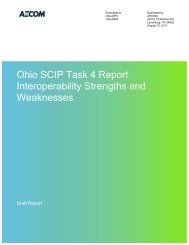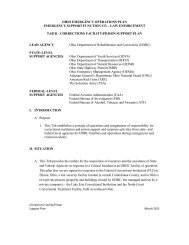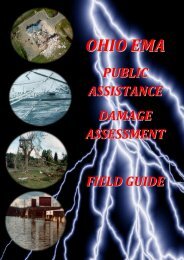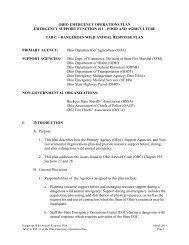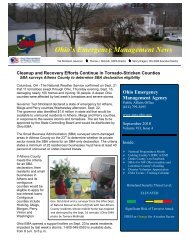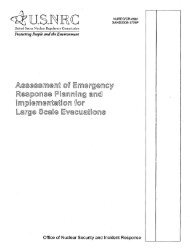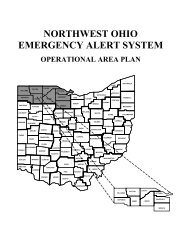wmd and hazardous materials response and decontamination
wmd and hazardous materials response and decontamination
wmd and hazardous materials response and decontamination
You also want an ePaper? Increase the reach of your titles
YUMPU automatically turns print PDFs into web optimized ePapers that Google loves.
RESPOND MISSION: WMD AND HAZARDOUS MATERIALS RESPONSE AND DECONTAMINATION• Decontamination priorities will be set up using the following priorities, in order of importance: lifesafety, incident stabilization, <strong>and</strong> property conservation.• All fires are extinguished in 4-day <strong>response</strong> phase.• Water-based oil release may extend beyond the 96-hour limit. Assets will be on scene, butcontainment operations may not be able to begin immediately on arrival.• Three operational <strong>response</strong> areas: port, refinery, <strong>and</strong> downwind• The <strong>response</strong> phase is 96 hours.• Local <strong>response</strong> time: 0–2 hours• Regional <strong>response</strong> time: 2–12 hours• State <strong>response</strong> time: 12–24 hours• Federal <strong>response</strong> time: 24+ hours• “Zero hour” (incident clock) = time incident occurred• Unconstrained need: consider all assets required for <strong>response</strong>, do not factor <strong>response</strong> time or assetavailability into planning.• Planning factors are based on scenario <strong>and</strong> planning assumptions for a level III <strong>hazardous</strong> <strong>materials</strong>(hazmat) incident, where there are 1,000 injuries, 350 deaths, 25,000 sheltered, 10,000 evacuated, <strong>and</strong>100,000 self-evacuated. About half of equipment <strong>and</strong> facilities are damaged (of three refineries). Twoships sank, the port was damaged near improvised explosive device (IED) sites, <strong>and</strong> property wasdamaged in the downwind area.• A significant number of individuals exposed to a plume cloud or contaminant agent will flee thescene before first responders arrive. It may prove difficult to determine which of those individualsrequire <strong>decontamination</strong>, <strong>and</strong> to ensure such individuals present themselves for <strong>decontamination</strong>.• The United States has approximately 64 nuclear stations supported by the Radiological EmergencyPreparedness Program (REPP). No less than 30 REPP <strong>response</strong> teams should be able to respond to an“improvised nuclear device” scenario within 24 hours.• Quantity of resources is achievable through mutual aid.• Each jurisdiction is expected to sponsor <strong>and</strong> support community emergency <strong>response</strong> teams (CERTs).• The projected effects of contamination resulting from a catastrophic incident are generally based onan estimated population density of 2,000 people per square mile, but may increase for major urbanareas.• Large-gathering situations (e.g. National Security special events, sporting events, conventions, etc.)create higher localized population densities.• Biological agents typically have delayed symptoms. As such there will rarely be an on-site incidentrequiring <strong>response</strong> when a biological agent is released.• Health care facilities are the most likely locations for managing a biological incident.• Secondary contamination will be a major concern. Hospital emergency rooms may close if patientsare admitted without proper <strong>decontamination</strong>. Other secondary contamination issues include controlof runoff of fluids used in <strong>decontamination</strong>, <strong>and</strong> the h<strong>and</strong>ling of contaminated clothing <strong>and</strong> personaleffects. In addition, the secondary contamination of first responders, even those wearing personalprotective equipment, can occur during the removal of patients from a <strong>hazardous</strong> area, during theperformance of basic life support functions, or when initial responders are unaware that a <strong>hazardous</strong>material is involved.• The psychological dimensions of being exposed to a contaminant, <strong>and</strong> subsequent <strong>decontamination</strong>may present social management challenges <strong>and</strong> concerns. Of greatest concern are the short- <strong>and</strong>long-term psychological consequences resulting from actual exposure to chemical, biological, <strong>and</strong>radiological substances, <strong>and</strong> which subsequently produce negative health effects. Short-term stresssymptoms may be a prelude to long-term, debilitating, post-traumatic stress disorder.372 Target Capabilities List



